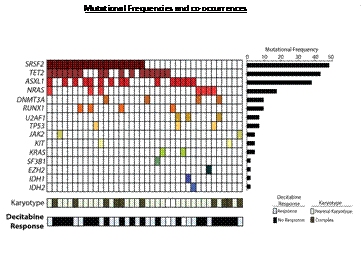Abstract
The nucleoside analog (na) 5-aza-2’-deoxycytidine (dac) has good, but heterogeneous, efficacy in the therapy of chronic myelomonocytic leukemia (cmml). Given that no standard therapy has been identified so far for cmml, there is urgent need to identify molecular markers that could support the choice of dac therapy and identify patients more prone to respond. Recently, we demonstrated that in mds patients the expression of uck1, involved in the activation of azacitidine, may influence the clinical response to this treatment (valencia et al, leukemia 2013). In the present study, we assessed the role of dac metabolizing enzymes as well as genetic alterations common to cmml patients in response to dac in a uniformly and prospectively treated cohort of cmml patients.
Methods:
Patients Forty cmml patients were treated with dac 20mg/m2/day for 5 days every 28 d. DNA and rna were extracted from bm mononuclear cells of 19 pts defined as responders to dac (r), and 21 as non-responders (nr). Hematological response was evaluated according to iwg 2006 criteria.
Gene mutation. the fifteen most frequently mutated genes in cmml were sequenced at a mean depth of coverage of 520x (range 169–714x).
Functional studies. the role of two main genes involved in dac metabolism: dck (dac activation) and dctd (dac deactivation) was evaluated by silencing both genes with sirnas. The experiments were performed in the mds-skm1 cell line and in primary cells of 6 cmml cases exposed in vitro to dac 10um for 48h.
Gene expression. the expression level of genes hent1, hent2, dctd, hcnt3, cn-ii, dck and cda, involved in dac metabolism was evaluated by qrt-pcr in 38/40 cmml patients and by rnaseq in 14/40 patients. CDNA libraries were sequenced using the hiseq 2000. The counts of endogenous genes were normalized by ercc spike-in library controls, and differential expression analysis was performed using edger (v3.4.2) glm model. The differentially expressed genes were identified at the fdr cutoff of 0.05 and absolute fold change greater than 2.
Results: in skm-1 cells and in cmml primary mononuclear cells, dctd silencing increased dac- induced apoptosis (annexin v-positive cells 20.2%±0.8% vs control 13.8%±0.5%; p=0.01). dck silencing led to a decrease in dac-induced apoptosis (annexin v-positive cells 8.8%±0.1% vs control 13.8%±0.5%; p=0.05). We could not detect by rnaseq a significant difference in the expression levels of na metabolizing enzymes between responders and non responders to dac. qrt-pcr confirmed these observations.
The mutational frequencies (figure) in this cohort of cmml cases were: srsf2 50%, tet2 44.7%, asxl1 39.4%, nras 18.4%, runx1 and dnmt3a 10.5%, u2af1 and tp53 7.8%, kras, jak2 and kit 5.2%, ezh2, idh1, idh2 and sf3b1 2.6%. No single genetic alteration was significantly associated with shorter overall survival or resistance to dac.
Conclusions: although we could clearly demonstrate that in vitro expression of dac metabolizing enzymes influenced response to dac, clinical resistance does not appear to be directly correlated with the expression of genes involved in dac metabolism nor to specific gene mutations and is likely determined by other clinical/molecular variables that remain to be identified.
Finelli:Janssen: Speaker, Speaker Other; Novartis: Speaker, Speaker Other; Celgene: Research Funding, Speaker Other.
Author notes
Asterisk with author names denotes non-ASH members.


This feature is available to Subscribers Only
Sign In or Create an Account Close Modal